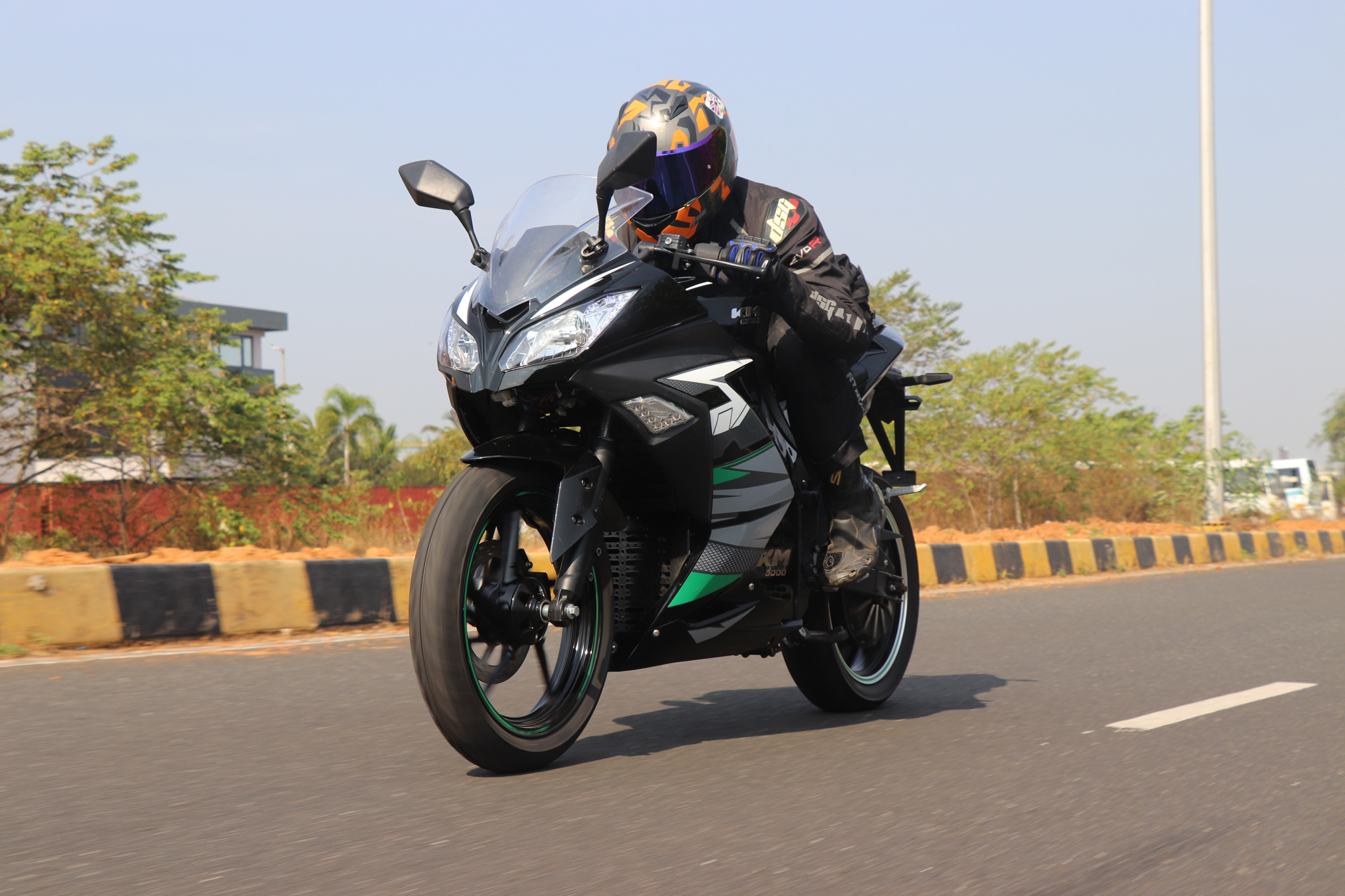KM3000 and KM4000 review | Kabira Mobility’s EV prototypes ridden
Goa based start-up Kabira Mobility has two new electric motorcycles, KM3000 and KM4000; we find out if they're worth your attention
 KM3000 reminds you of the Ninja 300
KM3000 reminds you of the Ninja 300In the quaint little town of Verna in Goa, something promising is brewing up. Kabira Mobility, a new EV start-up that we first saw at the Auto Expo 2020, has its manufacturing unit and an R&D centre nestled in Verna and we’re here to ride the early prototypes of two of its upcoming all electric motorcycles, the KM3000, a faired sports bike and the KM4000, a naked. Both are claimed to be the fastest electric motorcycles in India, but I find that hard to believe because the e-motorcycles are likely to be bested by the Ultraviolette F77 and the Emflux One, both of which pack more powerful e-motors and are slated to go on sale by mid-2021. Anyway, is this something you should look forward to?
KM3000
I can’t help but think of the Kawasaki Ninja 300 when I glance at the KM3000, particularly because of the aggressively styled dual headlamps and a sporty fuel tank. There’s of course no fuel to be filled and there’s a type two charging port in place of the fuel filling lid. This is the same type of CCS connector that’s used in most other EVs like the Ather 450 series, Nexon EV and so on. The 4kWh lithium-ion battery itself is positioned low and in the middle of a diamond frame giving it a low centre of gravity, aiding stability. Also, the rear brake lever is where the clutch lever is normally positioned on ICE motorcycles and that takes some time getting used to.
 Kabira Mobility KM3000
Kabira Mobility KM3000In terms of ergonomics, the riding position feels aggressive and you’re seated leaned forward, but the width of the handlebar was too narrow for my liking. A wider bar opens the chest and gives more leverage for steering, making the motorcycle easier to control and steer.
Apart from the fact that this design doesn’t exactly feel original, it’s early to draw a conclusion on the fit and finish. There were exposed wire harnesses, the welding around the battery was poorly finished, and the instrument cluster was offset but we’re expecting these issues to be sorted out by the time the KM3000 goes on sale. The suspension is still under development and felt extremely stiff on our test ride, lacking any sort of compliance over bad roads. The headline figures however seem impressive on paper — the 8bhp motor can power the KM3000 up to a 100kmph and in Eco Mode, range is 120km. Claimed charging time from 0-80 per cent in the ‘Boost’ charging mode is 50 minutes.
All the prototypes at the ride event packed different performances, some were locked at certain speeds while others felt faster. The motorcycle allotted to me felt peppy, but there the inherent aggressive acceleration that one usually expects from EVs if missing. On some bikes, the speedos were not working and on others the cluster wouldn't show accurate speeds, so I can’t exactly tell you what the top whack was, but it felt like the KM3000 topped out somewhere around 85kmph. That’s not far from the 100kmph claimed top speed and we hope that the production motorcycle manages to hit the claimed figure.
 KM3000 is the faired sibling
KM3000 is the faired siblingIn terms of stopping power, there’s no ABS on offer and CBS is standard on both the models. Single discs at both ends do a fine job of bringing the e-motorcycles to a halt.
KM4000
Oddly enough, the KM4000 is positioned as the more usable street motorcycle but it packs more punch and feels sportier. It has a higher top speed of 120kmph (20kmph+), sports a more powerful 11bhp electric motor, has a larger 4.4kWh battery pack for more range (150km) and features dual discs upfront. The 0-40kmph acceleration time is also quicker by 0.2 seconds with the KM4000 sprinting up to a 40kmph in 3.1 seconds (claimed) as opposed to the 3.3 seconds figure of its faired sibling.
 KM4000 is the sportier of the two
KM4000 is the sportier of the twoThanks to upright handlebars, the riding position on the KM4000 feels more relaxed and feels more usable. There’s a large Bluetooth enabled instrument console on both the bikes that displays a range of information including battery status, speed, riding modes and riding statistics, but the display was poorly lit and inaccurate.
In terms of performance the KM4000 felt slightly peppier than its naked sibling and also felt faster on the straights. The throttle response is sharp but there’s no mountain of torque that makes you cling onto the tank or the handle bar, and the acceleration is rather linear. 0-40kmph feels quick but after that the KM4000 takes its a while before hitting the top speed. Both motorcycles feel more of regular city commuters as opposed to ones that you would take on a joy ride out of town, starkly contrasting to the marketing speak.
Conclusion
Kabira Mobility has achieved over 90 per cent localisation and only the battery cells and some PCDs (portable computing devices) are imported. The startup’s EVs are currently sold in T1 cities in Karnataka, Maharashtra and Goa through their HelloEV stores, and the network will be expanded in the coming months to Gujarat and Telangana as well. However, at Rs 1.23 lakh for the KM3000 and Rs 1.37 lakh for KM4000, ex-showroom, Goa these electric motorcycles won't particularly be affordable when deliveries begin by May. If Kabira Mobility manages to improve the quality of the bodywork and general fit and finish on these bikes, they could be a decent enough alternative to the Revolt EVs.


